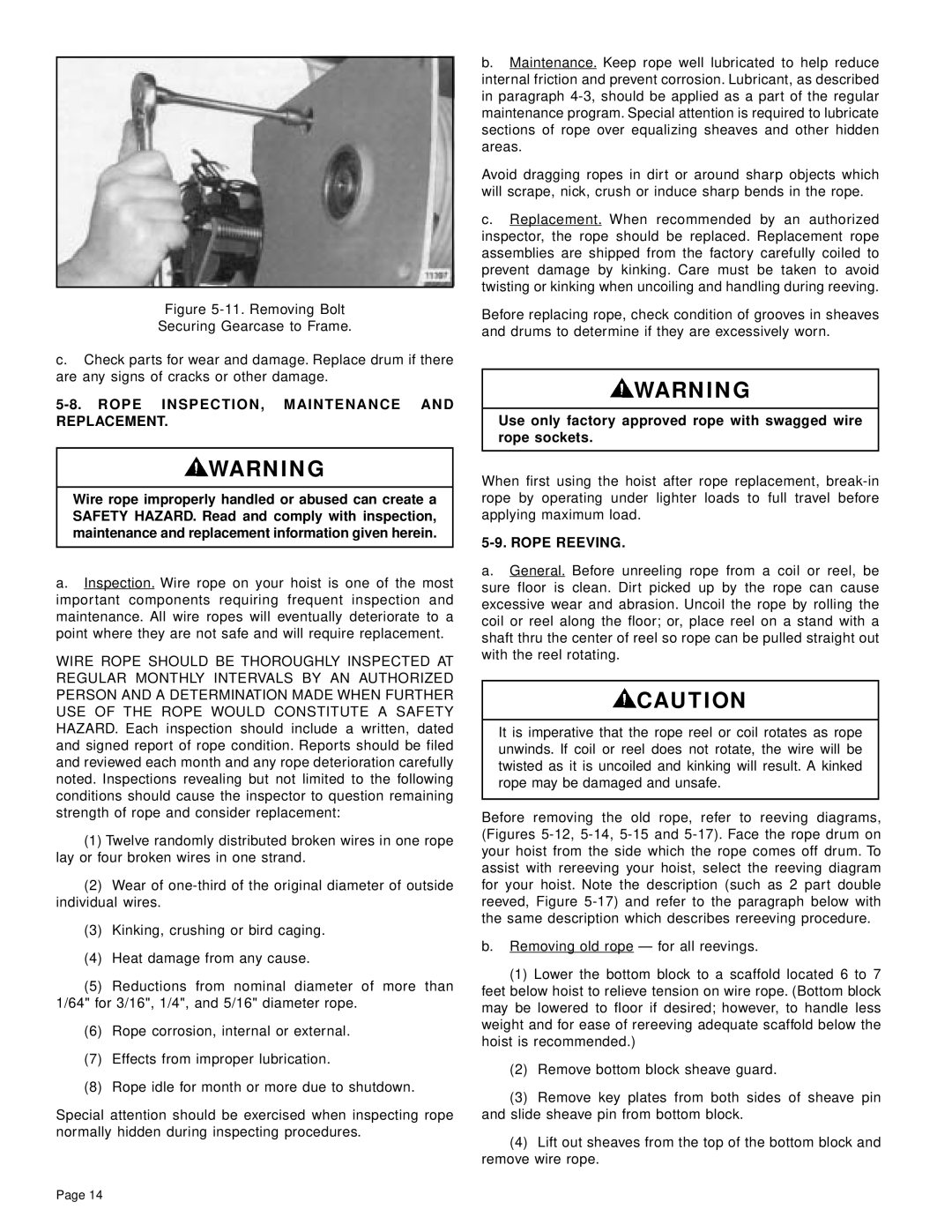
Figure 5-11. Removing Bolt
Securing Gearcase to Frame.
c.Check parts for wear and damage. Replace drum if there are any signs of cracks or other damage.
5-8. ROPE INSPECTION, MAINTENANCE AND REPLACEMENT.
![]() WARNING
WARNING
Wire rope improperly handled or abused can create a SAFETY HAZARD. Read and comply with inspection, maintenance and replacement information given herein.
a.Inspection. Wire rope on your hoist is one of the most important components requiring frequent inspection and maintenance. All wire ropes will eventually deteriorate to a point where they are not safe and will require replacement.
WIRE ROPE SHOULD BE THOROUGHLY INSPECTED AT REGULAR MONTHLY INTERVALS BY AN AUTHORIZED PERSON AND A DETERMINATION MADE WHEN FURTHER USE OF THE ROPE WOULD CONSTITUTE A SAFETY HAZARD. Each inspection should include a written, dated and signed report of rope condition. Reports should be filed and reviewed each month and any rope deterioration carefully noted. Inspections revealing but not limited to the following conditions should cause the inspector to question remaining strength of rope and consider replacement:
(1)Twelve randomly distributed broken wires in one rope lay or four broken wires in one strand.
(2)Wear of
(3)Kinking, crushing or bird caging.
(4)Heat damage from any cause.
(5)Reductions from nominal diameter of more than 1/64" for 3/16", 1/4", and 5/16" diameter rope.
(6)Rope corrosion, internal or external.
(7)Effects from improper lubrication.
(8)Rope idle for month or more due to shutdown.
Special attention should be exercised when inspecting rope normally hidden during inspecting procedures.
b.Maintenance. Keep rope well lubricated to help reduce internal friction and prevent corrosion. Lubricant, as described in paragraph
Avoid dragging ropes in dirt or around sharp objects which will scrape, nick, crush or induce sharp bends in the rope.
c.Replacement. When recommended by an authorized inspector, the rope should be replaced. Replacement rope assemblies are shipped from the factory carefully coiled to prevent damage by kinking. Care must be taken to avoid twisting or kinking when uncoiling and handling during reeving.
Before replacing rope, check condition of grooves in sheaves and drums to determine if they are excessively worn.
![]() WARNING
WARNING
Use only factory approved rope with swagged wire rope sockets.
When first using the hoist after rope replacement,
5-9. ROPE REEVING.
a.General. Before unreeling rope from a coil or reel, be sure floor is clean. Dirt picked up by the rope can cause excessive wear and abrasion. Uncoil the rope by rolling the coil or reel along the floor; or, place reel on a stand with a shaft thru the center of reel so rope can be pulled straight out with the reel rotating.
![]() CAUTION
CAUTION
It is imperative that the rope reel or coil rotates as rope unwinds. If coil or reel does not rotate, the wire will be twisted as it is uncoiled and kinking will result. A kinked rope may be damaged and unsafe.
Before removing the old rope, refer to reeving diagrams, (Figures
b.Removing old rope — for all reevings.
(1)Lower the bottom block to a scaffold located 6 to 7 feet below hoist to relieve tension on wire rope. (Bottom block may be lowered to floor if desired; however, to handle less weight and for ease of rereeving adequate scaffold below the hoist is recommended.)
(2)Remove bottom block sheave guard.
(3)Remove key plates from both sides of sheave pin and slide sheave pin from bottom block.
(4)Lift out sheaves from the top of the bottom block and remove wire rope.
Page 14
